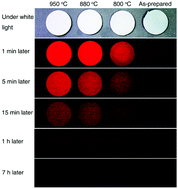Novel Cr3+ doped zinc gallogermanate (ZGGO) nanoparticles with 697 nm near-infrared (NIR) super long afterglow were prepared via a hydrothermal method. Subsequently, a vacuum-annealing strategy was adopted to improve NIR afterglow in ZGGO:Cr3+ nanoparticles. For the sample annealed at 800 °C, no variation in the particle size is observed, the persistent luminescence increases by an order of magnitude (∼14 times) and the NIR afterglow time reaches more than 15 hours relative to the as-prepared sample. After annealing at temperatures higher than 880 °C, the persistent luminescence of the nanoparticles is enhanced, but they show aggregated-surface behavior. Meanwhile, shallow and deep traps are generated, related to the  antisite defects and VGe–Cr3+–VO defect clusters, respectively. Finally, we apply ZGGO:Cr3+ persistent luminescence nanoparticles (PLNPs) to a human serum albumin (HSA) colloid solution, and more than 1 h of NIR persistent luminescence is detected under 320 nm excitation. The quenching effect of NIR luminescence by OH− in the HSA solution is observed based on the reduced contribution of surface Cr3+ in PLNPs to NIR luminescence. Our results suggest that ZGGO:Cr3+ PLNPs have potential applications for in vivo bio-imaging.
antisite defects and VGe–Cr3+–VO defect clusters, respectively. Finally, we apply ZGGO:Cr3+ persistent luminescence nanoparticles (PLNPs) to a human serum albumin (HSA) colloid solution, and more than 1 h of NIR persistent luminescence is detected under 320 nm excitation. The quenching effect of NIR luminescence by OH− in the HSA solution is observed based on the reduced contribution of surface Cr3+ in PLNPs to NIR luminescence. Our results suggest that ZGGO:Cr3+ PLNPs have potential applications for in vivo bio-imaging.

